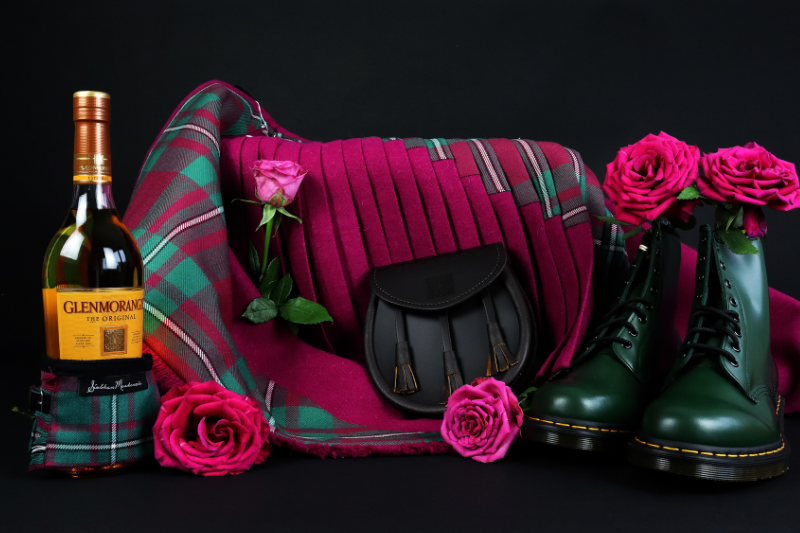What are kilts?
The traditional Scottish kilt is a piece of tartan worn around the waist. A Scottish kilt is often accompanied by a sporran (small pouch worn around the waist), a kilt pin (a heavy pin) and a Sgian Dubh (small dagger placed in the sock).
What is the history of the kilt?
It’s believed that the history of the Scottish kilt dates back to the 16th century. Historically known as the feileadh-mòr in Gaelic or the great kilt, the kilt was a full-length garment which could be draped over the shoulder. The small kilt, similar to the kilt we know today, is believed to have its origins in the 17th or 18th century.

Photo credit: ACME ATELIER
The evolution of the Scottish kilt
The Scottish kilt has been constantly evolved over the centuries. Today, Scottish kiltmakers are nurturing the traditional craft whilst promoting a modern take on the traditional kilt.
One designer focusing on the modern Scottish kilt is Howie Nicholsby, creator and designer of 21st Century Kilts. Howie comes from a family of traditional kiltmakers. At the age of 18, he became fascinated by kilt design and created his own kilt with an unexpected modern twist.
Howie has since kilted many famous Scottish people such as Brian Cox and Eddie Izzard. He even kilted Sir Billy Connolly for the NYC Tartan Day Parade.
Howie experimented with detachable pockets and a range of materials such as PVC and denim. Howie’s mission is to make the kilt more accessible for everyone, even for people without a clan or tartan connection, such as himself.
As part of the evolution of the kilt, many designers are making the kilt more accessible. Bespoke kiltmaker Andrea Chappell of ACME ATELIER highlights the importance of nurturing the traditional craft whilst challenging “the modern associations we have with the kilt as a formal garment of highland dress.”
Andrea wants to change the way people see the kilt by promoting “the more inclusive, international history of its style and function which has been adapted and evolved over time.”
Siobhan, director of Siobhan Mackenzie, wants to re-think the kilt and reflect our welcoming, inclusive culture. She said: “It’s incredibly important to me to nurture traditional craftmanship in Scotland, working with weaving mills and garment manufacturers with a honed craft.”
Siobhan continued: “There will always be a place for tradition, but I have fun with experimenting and innovating aspects whilst retaining the core craft.”

Photo credit: Matt Brown
Embracing the modern kilt
One designer blending tradition with new thinking is Siobhan Mackenzie. Siobhan established her business after working on a graduate collection focused on modernising kilts as a fashion design student.
Siobhan said: “A graduate collection is supposed to (be) innovative therefore I delved into my Highland heritage, trained in traditional kilt-making and implemented modern design thinking to create my collection.”
Siobhan works with a range of materials to create her contemporary kilts. Siobhan said: “I mostly work with wool - sustainability is a huge factor in my business”. She added: “I also keep everything and repurpose materials into collections such as my silk tartan collection - waste was never an option in my house growing up.”
Siobhan established her business just five days after graduating from university, aged twenty-one. She said: “It sounds cliché, but I love living my dream - I’ve wanted to be a designer since I was ten years old and learnt to sew at only thirteen, I’ve been on a mission since then to forge my way in the industry and I feel incredibly lucky to get to be creative every day and do my dream job."

Photo credit: Siobhan Mackenzie
Sustainability in the world of kiltmaking
As the kilt evolves to meet today’s challenges, Scottish kiltmakers are finding innovative ways to promote sustainability.
Andrea Chappell of ACME ATELIER has created a circular fashion initiative called IV36 which redesigns and remakes existing garments and supports training for local people from Forres in Scotland.
Andrea said: “The IV36 Initiative was born when our craft entered the HCA Red List of Endangered Crafts in 2021.”
She added: “The initiative makes use of abundant local resources which would otherwise go to waste (post-consumer - donated garments, pre-consumer - mill damaged cloth, agricultural - local farmers fleece) as well as my own studio offcuts.”
The sale of each IV36 item also returns 20% to fund the training of a local person from Forres in kiltmaking. Andrea explained: “The first IV36 trainee has been working with me for 18 months now and there are three more waiting in the wings - including a ten-year-old boy!”
As well as providing training, Andrea said she is also “passionate about the broader possibilities that stem from collaborative practice, bringing kiltmaking into other disciplines - particularly printmaking, weaving and embroidery - to create contemporary options that continue to broaden the appeal of this beautiful garment.”
Thanks to innovative designers like Howie, Siobhan and Andrea, the Scottish kilt is a modern and everyday garment that is responding to 21st century challenges whilst preserving our cultural heritage.
To learn more about the Scottish kilt, discover the history and origins of Scottish tartan. You can also find out more about Scotland's rich cultural heritage.
*Header image photo credit: VisitScotland/Kenny Lam